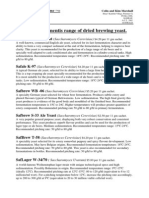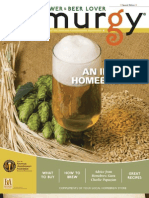Cask Cleaning
Cask Cleaning
Uploaded by
de_klusCopyright:
Available Formats
Cask Cleaning
Cask Cleaning
Uploaded by
de_klusOriginal Description:
Copyright
Available Formats
Share this document
Did you find this document useful?
Is this content inappropriate?
Copyright:
Available Formats
Cask Cleaning
Cask Cleaning
Uploaded by
de_klusCopyright:
Available Formats
Keeping it Clean Author Issue Daniel Pambianchi Jan/Feb 2008
Beer and barrels just seem to go together at least in some drinking songs. However, in modern breweries, beer is usually found in stainless steel vessels. These days, why would you store beer in a vessel with a potential for sanitation issues, that slowly lets in oxygen as the beer is aged and cant hold pressure? There are a couple possible answers to this question. Some brewers age their beer in bourbon barrels to impart a mixed oak and whiskey flavor to their beers. (See the October 2006 issue of BYO for more on using bourbon barrels.) Others brew sour beers and the bugs in the wood and oxygen permeability might be just what they are looking for. Finally, some brewers may simply be looking to add a little oak character to a regular (non-sour) beer. This article will explain how to maintain a new, clean barrel for oak-aging your beer. Buying a Barrel When you first buy a barrel, new or used, thoroughly inspect the interior and exterior of the barrel for any potential problems. Visually inspect the interior by inserting a small light source through the bung hole. Look for any obvious wood defects, wide joint gaps, or excessively charred wood resulting from over-toasting. Toasted wood should have a smooth finish with a uniform brownish color. Charred wood will look damaged and can be easily detected because it has a very dark brown, almost black, color. On the exterior, ensure that stave and head joints are narrow and tight, hoops are properly fastened, and the bung hole is tapered and not damaged. New Barrel Maintenance To minimize maintenance, wait to buy new barrels until you are ready to use them. Otherwise, store empty barrels in a cool and humid area, 55 F (13 C) and 6575 percent humidity, respectively, and away from dampness, to minimize shrinkage. Protect empty barrels from spoilage organisms by burning sulfur inside the barrels to replace the air with sulfur dioxide (SO2) gas. Barrels can be stored empty for an indefinite amount of time when properly preserved with sulfur. Once a month, gently sniff the inside of each barrel to determine if any SO2 gas is still present. If detected, simply replace the bung; otherwise, burn more sulfur. Be sure to work in a well-ventilated area and avoid inhaling SO2 gas. A sulfur bung for burning sulfur sticks or discs can be used for this purpose. This device which can be found at most winemaking shops is used to hold burning sulfur and prevent sulfur deposits from falling into the barrel. Deposits left in the barrel will interact
with beer during aging, causing hydrogen sulfide (H2S) to form. To prepare an empty barrel for storage, thoroughly rinse the interior with water and let it drain completely. No puddling of water should remain in the bilge; otherwise, it will cause sulfur dioxide gas to hydrate and form into sulfurous acid. Light a piece of sulfur stick and deposit it in the metal container at the bottom of the sulfur bung. If using a sulfur disc, place it on the hook over the metal container, and light it. Insert the burning sulfur attachment in the barrel and seat the wooden bung in the hole. The sulfur will burn completely in a few minutes to fill the barrel with gas. Remove the sulfur bung and quickly insert a wooden bung to prevent gas from escaping. Do not attempt to sanitize a used bourbon barrel in this manner. Alcohol vapors and open flame are a bad combination. New Barrel Preparation A new barrel must be swelled with clean water before transferring beer into it; otherwise, it will leak. If beer leaks through stave or head joints, or the croze, there may be considerable loss. There may also be premature oxidation of the beer as air enters the barrel. Eventually, if untreated, mold will form on the exterior surface and will penetrate through the joints to contaminate the beer. By swelling barrels, all joints will tighten to eliminate any possibility of beer seepage and prevent spoilage problems. You can swell a new barrel using a hot-water treatment or using an overnight watersoaking treatment. First, let all the SO2 gas out and thoroughly rinse the inside of the barrel with lukewarm water. The hot-water treatment method is very effective and requires little water. Pour approximately a 20 percent volume of very hot, steamy, clean tap water into the barrel. For example, use three gallons (11 L) of hot water for a 15-gallon (57-L) barrel. Bung the barrel and slosh it around to soak the entire interior surface. The vapor pressure and hot water significantly accelerate barrel swelling and plug any seepage through joints. Continue sloshing the barrel until there is no more leakage. Then place it upright and let the head area soak until there is no more leakage. Repeat with the other head area. When done, let the water drain completely and let the barrel dry and cool down before transferring beer into it. If the barrel does not stop leaking within one hour of pouring the hot water, proceed with an overnight treatment. The overnight treatment should fix any leakage unless the barrel is defective. However, it will leach out some of the oak flavor owing to the longer soak period. This is fine for new barrels because you may want to reduce the amount of oak that will be imparted to that first batch of beer. Fill the barrel to the top with cool water and let it soak overnight. Initially, the barrel may
leak but it should stop after a few hours or a day. The soak period should never exceed 2436 hours with the same water to avoid mold developing and penetrating the barrel. If there is still leakage, refill the barrel and repeat until leakage stops. If leakage does not stop after four to five days, the barrel is defective and should be returned to your supplier. When leakage has stopped, drain the water out of the barrel by placing it in the bungdown position. Let the barrel stand for an hour or two and then fill it immediately with beer. The barrels exterior surface requires no special preparation, although you should inspect it regularly for any mold. Used Barrel Maintenance Used barrels must also be properly stored and maintained; however, since these previously contained beer or another liquid, a different maintenance program is recommended. If used barrels are to be stored empty, rinse them several times with clean water, and drain. If left empty, the barrel wood will dry and shrink over time, and will therefore require to be swelled again when transferring beer into it. An effective alternative is to fill and store barrels with a sulfur-citric holding solution. This holding solution will promote sanitation, keep the barrels swelled and smelling sweet. It is not recommended for new barrels, barrels less than one year old or barrels previously holding spirits such as bourbon since precious oak or other flavors would be stripped. The holding solution is prepared using 1 tsp of citric acid and 1.5 tsp of potassium metabisulfite for each gallon (4 L) of barrel volume. Dissolve these in one gallon of hot water. Fill the barrel two-thirds with water, add the holding solution, top up the barrel with cool water, and bung the barrel. Top up the barrel with a holding solution once a month to replace lost solution. The barrel can be stored indefinitely without the risk of spoilage. During storage, rotate the barrel 45 in either direction every time you top up to keep the bung area soaked. This will prevent the bung area from drying out and protect it from spoilage organism growth. The sulfur-citric holding solution will etch a concrete floor. Rinse the floor with water to prevent this. Used barrels require no special preparation beyond a simple water rinse, if desired, when transferring beer out and in immediately. If the barrel has been stored with a holding solution, drain the barrel and rinse it thoroughly with clean water before transferring beer into it. Barrel Bugs Sanitation can be a problem with oak barrels. Penicillium mold a blue-green fungus is the most common spoilage problem and can be very difficult to eradicate. Typically, it will grow through joints or around the bung hole in barrels that have not been properly
swelled. The usual suspects may also inhabit the wood in a barrel. These include Acetobacter (especially in barrels that are not topped up regularly), Brettanomyces (which can subsist on the wood cellulose sugars in new barrels), Lactobacillis and Pediococcus. To treat any of the above spoilage problems, prepare an alkaline solution by dissolving either sodium carbonate or sodium percarbonate in water at a rate of 1 tsp per gallon (or use 1 g/L) for mild spoilage problems or up to a maximum of 3 tsp for more serious problems. Fill the barrel two-thirds of the way with water, add the solution to the barrel and then top up with water. Let the barrel soak overnight, empty it and neutralize any remaining alkaline residues using a citric acid solution. Prepare the citric acid solution by dissolving citric acid powder in one gallon of water. Use 1 tsp of powder for each gallon of barrel volume. For example, dissolve 15 tsp. for a 15-gallon (57 L) barrel. Armed with these techniques, youll be able to roll out the barrel whenever you wish to wood-age a beer.
You might also like
- Ansi H35.2 (M) - 2009Document53 pagesAnsi H35.2 (M) - 2009Dee Dee100% (3)
- BJCPExamForDummies2018 Rev2Document67 pagesBJCPExamForDummies2018 Rev2ronsup75% (4)
- Zymurgy Bob's Making The CutsDocument2 pagesZymurgy Bob's Making The CutsTy Fitwilly100% (1)
- KveikDocument51 pagesKveikgaffodio hadrienNo ratings yet
- DCL YeastDocument2 pagesDCL YeastACBNo ratings yet
- Mastering The BJCP ExamDocument17 pagesMastering The BJCP Examhunteramor100% (2)
- FarmhouseDocument4 pagesFarmhouseDrVollNo ratings yet
- Balling Formula Scrutiny of A Brewing DogmaDocument8 pagesBalling Formula Scrutiny of A Brewing DogmaEvis Sandoval100% (1)
- YeastStarter PDFDocument6 pagesYeastStarter PDFHiran GonçalvesNo ratings yet
- Sour Beer PresentationDocument23 pagesSour Beer PresentationMarlon RebelloNo ratings yet
- Home Brewing Beer And Other Juicing Recipes: How to Brew Beer Explained in Simple Steps: How to Brew Beer Explained in Simple StepsFrom EverandHome Brewing Beer And Other Juicing Recipes: How to Brew Beer Explained in Simple Steps: How to Brew Beer Explained in Simple StepsNo ratings yet
- Home Brew Recipe Bible: An Incredible Array of 101 Craft Beer Recipes, From Classic Styles to Experimental WildsFrom EverandHome Brew Recipe Bible: An Incredible Array of 101 Craft Beer Recipes, From Classic Styles to Experimental WildsNo ratings yet
- Home Brewing: 70 Top Secrets & Tricks To Beer Brewing Right The First Time: A Guide To Home Brew Any Beer You Want (With Recipe Journal)From EverandHome Brewing: 70 Top Secrets & Tricks To Beer Brewing Right The First Time: A Guide To Home Brew Any Beer You Want (With Recipe Journal)No ratings yet
- CBC Online Seminar Presentation Draught Beer Quality Workshop Addressing Draught Beer Dispense IssuesDocument40 pagesCBC Online Seminar Presentation Draught Beer Quality Workshop Addressing Draught Beer Dispense IssuesAnh TuanNo ratings yet
- Beyond Malt HopsDocument46 pagesBeyond Malt Hopsbartolomej7No ratings yet
- Craft: The Brewers Association Guide To AmericanDocument16 pagesCraft: The Brewers Association Guide To AmericanMar KamonNo ratings yet
- 15 American IPAs1Document17 pages15 American IPAs1JohnRykerNo ratings yet
- Late Hop & Hop OilsDocument3 pagesLate Hop & Hop OilsBill LimaNo ratings yet
- Carbonatación de CervezaDocument19 pagesCarbonatación de CervezaAnonymous hP6ab2D1ppNo ratings yet
- TN 109 Beer Hop ExtractionDocument4 pagesTN 109 Beer Hop ExtractionMaxPostvanderBurgNo ratings yet
- Carbonation Volumes Pressure Temperature ChartDocument1 pageCarbonation Volumes Pressure Temperature ChartVohinh NgoNo ratings yet
- Castle Malting Brochure EngDocument40 pagesCastle Malting Brochure EngEmilio MachadoNo ratings yet
- Foam StabilityDocument7 pagesFoam StabilityJohanna CoronadoNo ratings yet
- Zymurgy Introduction To HomebrewingDocument44 pagesZymurgy Introduction To HomebrewingCoup CreeNo ratings yet
- Bhs Brewing Ind ShierDocument69 pagesBhs Brewing Ind Shieralmstick2076No ratings yet
- Belgian Beer Class 2018Document30 pagesBelgian Beer Class 2018michaelburke47No ratings yet
- 2014 MBAA Chris White Yeast ManagementDocument30 pages2014 MBAA Chris White Yeast ManagementAdrián LampazziNo ratings yet
- Morebeer! Beer Making Instructions: Morebeer! Personal Brewery Starter SystemDocument2 pagesMorebeer! Beer Making Instructions: Morebeer! Personal Brewery Starter SystemTeddy Riaño AlarconNo ratings yet
- 125th Anniversary Review: The Non-Biological Instability of BeerDocument10 pages125th Anniversary Review: The Non-Biological Instability of BeerkleitoneduardoNo ratings yet
- First Wort Hopping SummaryDocument5 pagesFirst Wort Hopping SummaryRodrigo Jacy Monteiro MartinsNo ratings yet
- Beer - Ingredients: Water. Beer Is Approximately 90 Percent Water. Not All Water Is IdealDocument8 pagesBeer - Ingredients: Water. Beer Is Approximately 90 Percent Water. Not All Water Is IdealFarhaan MohammedNo ratings yet
- 1-2 J Palmer Real Examples of Water AdjustmentDocument26 pages1-2 J Palmer Real Examples of Water Adjustmentrarasriwindhu100% (1)
- Zymurgy 1990 Vol 13-03 FallDocument72 pagesZymurgy 1990 Vol 13-03 FalllordmaulNo ratings yet
- Sour BeersDocument3 pagesSour Beersmauricio0327No ratings yet
- Yeast SubstitutionsDocument2 pagesYeast SubstitutionsBruno VintilaNo ratings yet
- CloneBrews 2nd Edition Marketing BrochureDocument2 pagesCloneBrews 2nd Edition Marketing BrochurejtajaraNo ratings yet
- 2011 - Workshop On US Hops - Matt BrynildsonDocument56 pages2011 - Workshop On US Hops - Matt BrynildsonGustavo Templar100% (1)
- The Top Twenty Scotch Whiskies in A Ranking ListDocument4 pagesThe Top Twenty Scotch Whiskies in A Ranking ListminRFNo ratings yet
- Belgian Dark Strong AleDocument11 pagesBelgian Dark Strong AleJean-Benoît OffieNo ratings yet
- Worth Boiling ScienceDocument3 pagesWorth Boiling ScienceMiguel MartínezNo ratings yet
- Thomas Hardy RecipesDocument4 pagesThomas Hardy RecipesTim McClureNo ratings yet
- Beer Judge Certification Program: Guide To Beer StylesDocument30 pagesBeer Judge Certification Program: Guide To Beer StylesazbrewerNo ratings yet
- Draught Beer Quality Manual - 2nd EditionDocument82 pagesDraught Beer Quality Manual - 2nd EditionMSalesNo ratings yet
- Isolation Wild YeastDocument6 pagesIsolation Wild YeastaguilaquecaeNo ratings yet
- Battre L'Oie Saison (All-Grain) - Beer RecipeDocument3 pagesBattre L'Oie Saison (All-Grain) - Beer RecipeRade Stevanovic100% (1)
- Zymurgy IBUsDocument13 pagesZymurgy IBUsyalunke3986100% (1)
- Smoked Beers History, Brewing Techniques, Recipes (Daniels, RayLarson, Geoffrey) (Z-Library)Document226 pagesSmoked Beers History, Brewing Techniques, Recipes (Daniels, RayLarson, Geoffrey) (Z-Library)mid79111100% (1)
- Hops A Brief HistoryDocument3 pagesHops A Brief HistoryAle Müller LyardetNo ratings yet
- CAMRA Beer Styles Guide For CBOB Leaflet Dec 2020 1Document12 pagesCAMRA Beer Styles Guide For CBOB Leaflet Dec 2020 12Aljibes Craft BeerNo ratings yet
- Review Beer AgeingDocument25 pagesReview Beer AgeingTimothy WestNo ratings yet
- Tricks Tips: Active Dry Yeast and Fermentation Explained To BrewersDocument17 pagesTricks Tips: Active Dry Yeast and Fermentation Explained To BrewersMauro ConsolaniNo ratings yet
- Turbidity of BeerDocument39 pagesTurbidity of BeerManuel Plata100% (1)
- Beer 101Document25 pagesBeer 101Juan Jose Garcia OrnelasNo ratings yet
- Best Practices Guide: QualityDocument24 pagesBest Practices Guide: QualityDavid HernandezNo ratings yet
- Stone Brewing Co. Info BookDocument32 pagesStone Brewing Co. Info Bookstonebrew100% (1)
- High Gravity BrewingDocument4 pagesHigh Gravity BrewingMohd SuhailNo ratings yet
- On Brewing Bavarian Helles v3 PDFDocument16 pagesOn Brewing Bavarian Helles v3 PDFBenson Matthew IshakNo ratings yet
- Brewing Cleaning and SanitationDocument1 pageBrewing Cleaning and SanitationJo SagaralNo ratings yet
- 2015 AHA Brewing Session BeerDocument16 pages2015 AHA Brewing Session BeerFelipe BaronyNo ratings yet
- Dynamics and Control System Design For Biodiesel TDocument7 pagesDynamics and Control System Design For Biodiesel TAverly Jerryl EscotoNo ratings yet
- CHAPTER 2 LiteratureDocument4 pagesCHAPTER 2 LiteratureJEMICA DARULLONo ratings yet
- Natural Products Chemistry. The Isolation of Trimyristin From NutmegDocument8 pagesNatural Products Chemistry. The Isolation of Trimyristin From NutmegIván CruzNo ratings yet
- Numerical Calculation of Simultaneous AbDocument6 pagesNumerical Calculation of Simultaneous AbEdoardo ScaggianteNo ratings yet
- SuperconductivityDocument30 pagesSuperconductivityAnna100% (1)
- NEXA Autocolor Car Process Chart 2017Document1 pageNEXA Autocolor Car Process Chart 2017Suhaib AbbasiNo ratings yet
- GATE Life Sciences Question Paper 2013Document27 pagesGATE Life Sciences Question Paper 2013Santhosh KalashNo ratings yet
- Overview of Petroleum Refining IIDocument19 pagesOverview of Petroleum Refining IIPradeep Munna100% (1)
- SSRN Id3439618Document10 pagesSSRN Id3439618firtaNo ratings yet
- 6.1D Step-By-Step Procedures For Melting Point DeterminationDocument5 pages6.1D Step-By-Step Procedures For Melting Point DeterminationAsto AtongNo ratings yet
- WHMIS 2015 QuizDocument3 pagesWHMIS 2015 Quizdrewtate99No ratings yet
- As and A Level Chemistry Core Practical 5 Oxidation of Ethanol Student Teacher TEchnician WorksheetsDocument7 pagesAs and A Level Chemistry Core Practical 5 Oxidation of Ethanol Student Teacher TEchnician WorksheetsonehllznNo ratings yet
- DNA Review AnswersDocument2 pagesDNA Review AnswersSpencer ChanNo ratings yet
- Natural Gas MSDSDocument4 pagesNatural Gas MSDSvinay1999No ratings yet
- Development of Methods For Determining Water Content in Oil UsingDocument120 pagesDevelopment of Methods For Determining Water Content in Oil Usinggilar herliana putraNo ratings yet
- General Guidance On "Hold-Time" Studies: Revised Draft For Comment (February 2014)Document12 pagesGeneral Guidance On "Hold-Time" Studies: Revised Draft For Comment (February 2014)جيلاني زيدانيNo ratings yet
- Antiplatelet Drug Comparison Chart (Asa-Clopi-Prasu-Tica)Document1 pageAntiplatelet Drug Comparison Chart (Asa-Clopi-Prasu-Tica)Ponpimol Odee BongkeawNo ratings yet
- Nickel Cadmium Battery MsdsDocument2 pagesNickel Cadmium Battery MsdsSuns Wahjoedhi100% (2)
- Using Aromatic Biological Markers As A Tool For Assessing Thermal Maturity of Source Rocks in TheDocument13 pagesUsing Aromatic Biological Markers As A Tool For Assessing Thermal Maturity of Source Rocks in TheMD Redwan IslamNo ratings yet
- Em - 1110 1 4010Document286 pagesEm - 1110 1 4010Marcio AlbertoNo ratings yet
- CBE 141-Chemical Engineering Thermodynamics Spring 2015Document4 pagesCBE 141-Chemical Engineering Thermodynamics Spring 2015GuntherNo ratings yet
- NuplazidDocument14 pagesNuplazidRaquelNo ratings yet
- Identify Whether The Following Processes Are Endothermic or Exothermic. Justify Your Answer On The Space ProvidedDocument5 pagesIdentify Whether The Following Processes Are Endothermic or Exothermic. Justify Your Answer On The Space ProvidedAngelique BarquillaNo ratings yet
- Bio204 Principles of Biochemical EngineeringDocument32 pagesBio204 Principles of Biochemical EngineeringHanifullah JanNo ratings yet
- Is50 ManualDocument36 pagesIs50 Manualnsh00No ratings yet
- W7011 StabilityDocument8 pagesW7011 StabilityLuis Alberto SaldañaNo ratings yet
- Biogas PlantDocument37 pagesBiogas PlantMahaManthra100% (1)
- Daftar Besi BajaDocument30 pagesDaftar Besi BajaMailbox AditNo ratings yet
- Advanced Analytical Quiz 5Document2 pagesAdvanced Analytical Quiz 5Kemikage Peter88% (16)

























































































